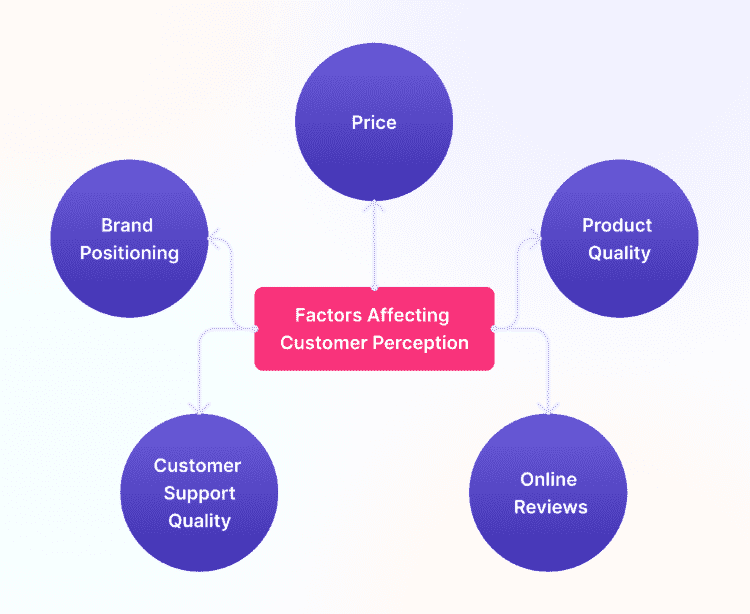REVE Chat Version 4.0
Version 4.0
Upgrade your website to an IM platform & beyond
Blending the strengths of IM and Live Chat
Upgrade your website to an instant messaging platform and beyond


Perception matters a lot when you’re in the business world!
It matters so much that 71% of consumers prefer to choose brands that align with their values.
In fact, outcomes are always positive for companies that are perceived well in the market.
Needless to say, companies that enjoy favorable customer opinions are often the ones that regularly break the ceiling and achieve remarkable success year in and year out.
On the other hand, businesses with poor customer perceived value find it hard to maximize their effort, struggle to realize the true potential, and in most cases, also get consigned to obscurity.
So, you should always strive to meet the expectations of customers if you want to be seen in a positive light and maintain a desired level of perception.
Customer perception meaning is about how customers feel and think about your business. It’s an opinion that is formed either through direct or indirect interaction with your company over a period of time. And perception could comprise both qualitative and subjective data, and it could be based on anything, whether the product, services, policies, the way you talk to customers, etc.
Naturally, many factors can contribute to the making of customer perceived value of your brand where some will be controllable while others will be beyond the control. You can not always decide how your business is perceived but can take measures to deliver value which in turn can improve customer experience or perception.
In fact, understanding how customers see your company can prove a great tool in improving the metrics and growing the business. More importantly, it will help you better understand what are customer needs and how to fulfil them effectively.
Brands that hope to achieve positive perception should understand how 33% of customers will leave a brand after just one bad experience. So, they need to constantly invest in keeping customers happy as it can help them create positive vibes in the market.
Consumer perception is vital for any business for many reasons.
Customers often form an opinion about a business based on many factors and not all will be in your control. And if you have the right customer experience strategy, you can easily work on most things that shape or break the perception and bring the desired improvement to the result. Similarly, there are so many aspects such as price, quality, positioning, etc. that can decide how your business is seen by others in the market.

Some of the key factors that always affect customer perception include –
Perception may be an intangible concept but it always has some visible hints or data that clearly indicate whether it’s positive or negative. And if you’re able to track those stats or feedback, you could be in a better position to exceed customer expectations and also gauge the way your business is perceived.
You can rely on some of these methods to measure customer perception.
Let’s look into each of the ways in detail;
Collecting customer feedback is always a first step towards understanding how your business is seen by others.
In fact, what your customers think about your business is something you should always need to track if you want to check what kind of reputation your brand enjoys in the market.
Whether your business has favorable or unfavorable customer feedback or views should be known so that you can take the measure to improve upon it.
Following up with customers after every interaction is a great practice to get feedback and know exactly how they think about your business.
When you follow up, or send a mail or call up the customer after an interaction, you get to understand whether or not they are satisfied with the product or service.
Regular follow-ups can also help you first gauge and then change the customer perception of service for your business.
Customers often discuss brands online. They talk about businesses all the time, whether happy or not.
And if you’re not tracking those social media and web conversations, you might miss out on an opportunity to understand their issues.
Top brands always make it a habit to keep an eye on online mentions and then reach out to customers to assuage their concerns if any.
And if you ignore online mentions, it would be difficult to measure customer perceived value. And you might also not understand the importance of customer value in the true sense.
Reviews and ratings are always an excellent way to understand customer pain points and take steps to resolve them.
They can also be quite a helpful customer perceived value example to understand how your brand is seen by others in the market.
When you invest in finding the issues that are troubling customers, it takes you a long way in becoming aware of the kind of perception they have about the business in an overall sense.
Whether customers give favorable or negative reviews, you need to take everything in your stride and reach out to them and assuage their concerns.
You should never hesitate in asking customers to rate your service. Doing this regularly can help you get a deep insight into consumer perception behavior and also into what else needs to be done more to ensure happy customers.
Similarly, you need to take stock of the customer service KPI to know how much they trust your business in the true sense. If you are offering quality customer service on a consistent basis, or if your products /service maintain the quality, customer perception will always be positive.
For that reason, you should start tracking customer satisfaction (CSAT) where you just need to ask everyone to rate support interaction. This way you will easily know whether customers are happy with the way their issue is resolved.
In the same way, you can measure NPS (net promoter score) to get a good idea about the level of customer loyalty your brand enjoys. Based on this metric, you can work on the customer perception data to achieve the results you look for.
Understanding the mood of the customers is key to gauging the kind of perception they would have about your business. If you’re able to decode emotions from textual or voice data, you can easily know whether customers are happy or unhappy, or whether they are angry or pleased.
Many businesses leverage the power of technology to mine the thoughts, opinions, or sentiments of customers in order to know the perception better. Based on the chatbot sentiment analysis, you can modify responses in tune with customers’ emotions and take steps to realize how customers think about you.
Psychographic data can be a wonderful tool to get personal with customers and understand how they see your business. When you have “attitudinal data”, you have information related to the lifestyles, goals, desires, and interests of the people who matter to your business and you can use it to serve them better.
Your business can prepare a variety of psychographic survey questions and present them to customers to understand brand perception in a big way. This kind of survey is quite helpful when it comes to understanding how customers from different demographics and audiences view the business.
Customers feel happy and stay loyal to a brand if they are offered good experiences. And when customers are happy, they always have a positive perception of the business. It shows how you need to focus on customer experience if you want to improve their perception of your business.
REVE Chat can help you in many ways to improve customer perception.
Live Chat – A multi-channel online live chat software solution can help deliver the best customer experience for websites and apps.
Chatbots – You can deliver automated customer support and boost sales conversions with AI chatbots using REVE Chat’s live chat platform.
Video chat – Brands can offer real-time customer service, increase online conversions and build customer loyalty with REVE Chat’s live video chat solution.
Co-browsing – The co-browsing feature can help you become collaborative and guide your customers smoothly without asking them to install any software.
Popular channels – Engage, support, and sell to your customers across popular channels such as website, Facebook, WhatsApp, Viber, etc and boost your brand perception.
There are many other ways as well to improve customer perception.
Customer perception is something that you always need to work for else it will become challenging to stay competitive in the marketplace. The focus should always be on adding to the customer experience and tracking their conversations across channels so that you become aware of how they think about your business.
With the right strategy, it’s quite possible to change the customer perceived value definition about your business and ensure a positive impact on the bottom line.
The core factors that affect consumer perception are 1) quality of products or services and 2) quality of customer support and communication. Check out REVE Chat’s useful tools that improve your customer support & communication and ultimately lead to better customer perception.
Start a 14-day free trial, no credit card required
Stay updated with the latest trends and ideas we share
What happens when your business doesn’t have a well-defined lead management process in place? You might then struggle to track,...
In your business, you need information about your customers’ pain points, preferences, requirements, and most importantly their feedback. Now think this...
How does the future look like to you with Artificial Intelligence shaping most of our day-to-day tasks? Sometimes it feels...


